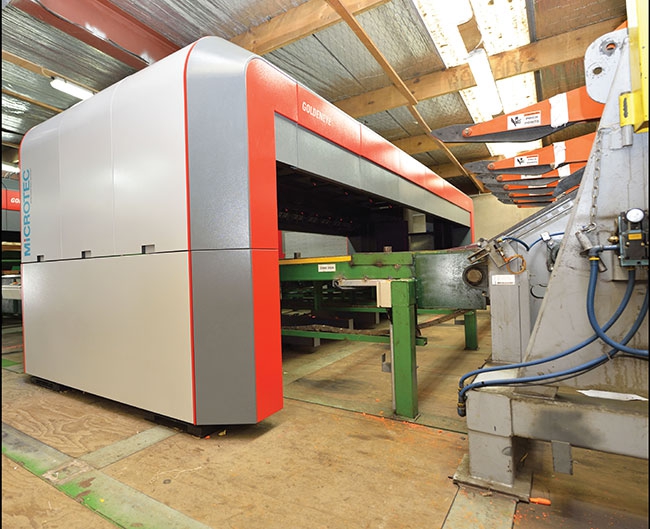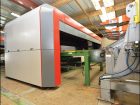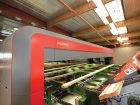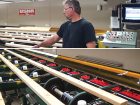
Industry News
Scanning and optimization
June 8, 2015 - Scanning and optimization technology in the planer mill – and the sawmill – is all about the ongoing maximization of profits. The more effective the technology, the greater its potential to save a processor money; therefore, it’s important to understand how the technology has evolved over the last few years and where it’s headed. That’s why Canadian Forest Industries has asked several industry experts for their insights and looked into the capabilities of the latest equipment coming to market.
June 8, 2015 By Treena Hein
 Goldeneye 900 Transverse scanner. Scanning and optimization technology in the planer mill – and the sawmill – is all about the ongoing maximization of profits.
Goldeneye 900 Transverse scanner. Scanning and optimization technology in the planer mill – and the sawmill – is all about the ongoing maximization of profits.“There have been major advances in scanning and optimization over the last five years,” says Darrell Wong, manager of the lumber manufacturing division of FPInnovations.
He notes that a variety of sensors, when used together, are able to detect a wide array of grade-determining characteristics, which when matched with appropriate optimization, enable reliable processing at much higher speeds.
Scanning and optimization research going forward will focus on two major areas: detailed strength measurement of logs and adapting advanced systems to unique applications and conditions.
Over the last few years, grade scanner manufacturers have begun to incorporate similar scanning technologies, resulting in scanners that are differentiated more by software capability rather than sensing technology, notes Norvin Laudon, chief technology officer at Springer Microtec, which has its Canadian headquarters in Vancouver, B.C.
“Over the next few years, I think customers will see companies make headway in differentiating themselves from each other again,” Laudon says.
One of the things that will allow this is computer tomography.
“CT scanning is here today in the sawmill, and it’s where we believe the future lies,” Laudon explains. “We have computer tomography scanners for logs, with five installations at sawmills around the world, and the ideas from that are starting to make their way into our planer mill scanning as well. Using a simplified multi-axis X-ray, we have developed a very accurate 3D pith locator for high speed planer mills.”
Accurate pith location, and therefore, accurate knot sizing, are very important for reducing above and below grade in the finished product, particularly in U.S. markets, he adds.
The need for speed
The other major advancement that could differentiate planer mill scanning and optimization tech over the next few years is camera speed.
“We need cameras to scan very quickly in the forestry industry and this sector is one of the most challenging applications for cameras,” Laudon says.
In a planer mill, lineal scanners have to process information at up to 4,000 feet a minute, and transverse scanners have to keep up with 240 lugs or more a minute, Laudon says.
Kevin Brown, vice-president of operations at SiCam Systems in Delta, B.C., agrees that the high speed of mills is now requiring scanning technology that works at a much faster rate.
“The sensor tech has come a long way in this over the past five years – in terms of accuracy, as well,” Brown says. “The need to detect finer details is becoming more important.”
He says the big challenges going forward are better camera speed technology and being able to process all the detailed data the cameras will gather so that the optimizer can use it in a timely manner.
Keep it simple
Simpler operation and maintenance are other factors that have come to the forefront in planer mill scanning and optimization in recent years.
Three years ago, USNR introduced its Transverse High Grader (THG), and its single-sensor design, created with simple operation and maintenance in mind.
The Parksville- and Salmon Arm, B.C.-based company has also made significant advances in software used to identify and classify defects. But as computing power increases, the company will harness new software tools and techniques to achieve even better grade accuracy, according to Scott Norton, vice-president of USNR’s optimization and process controls business.
“USNR today offers systems that tie optimizers throughout the sawmill and planer mill – particularly in the areas of operating status and daily reporting,” Norton says. “This functionality will continue to grow as well.”
SiCam
SiCam Systems offer scanning and optimization technology for the planer infeed and outfeed. Their products can measure and monitor the thickness and width of each piece, and can identify thin pieces on the infeed and trend size information on the outfeed.
This trending information can be used to analyze how the mill is performing over time, allowing customers to better plan maintenance and predict repairs. The data coming from one or both of the infeed or outfeed scan zones can be used by SiCam to provide customers with a close-loop size control application.
The data collected from the infeed can also be used to help analyze kiln drying performance.
USNR
The company’s newest planer mill scanning system, the THG, uses the same technologies and software algorithms as USNR’s family of automated grading systems, but is offered in a transverse package. All the scan data – laser profiles, colour vision, and GrainMap laser grain mapping – is correlated and verified for accuracy and reliability.
Mounted above the flow, it projects the grade determined by the optimizer directly onto each board, tracking that projection with the board as it passes by a check grader. The boards are not marked, so freshly-planed lumber remains clean and bright.
Integrating THG with USNR’s WinTally Sorter Management offers users a wide variety of lumber processing, sorting and packaging options.
Springer-Microtec
The company’s newest planer mill scanning system includes x-ray technology, which provides a non-invasive solution for detecting quality and strength-relevant wood defects. The longitudinal direction of the Multi-Sensor Scanner Goldeneye 800 line allows for feeding speeds up to 1,200 metres per minute. The system features biometric scanning for the recognition of wood defects in order to automate, streamline and optimize manufacturing processes.
The Goldeneye 900 provides 3D reconstruction and determines the quality of the surface of green and dry boards in transversal transport. The multi-sensor system features the integration of colour and laser scanners into one unit, and delivers a gapless view on the surface of lumber.
The company’s Crometic cameras feature Full HD resolution, fast image acquisition and on-chip image processing. The cameras are designed in-house, down to the chip level, specifically for wood scanning applications.
LMI
LMI Technologies, a Delta, B.C.-based supplier of sensor technology to OEMs and system integrators, is currently in the process of developing a next-generation sensor technology for planer mill finished lumber grading.
Print this page


